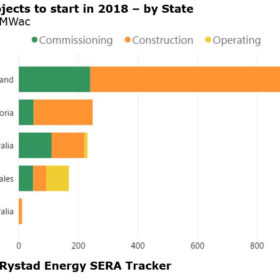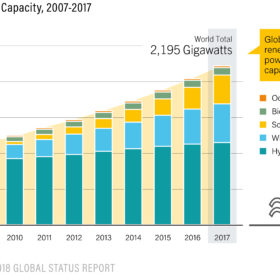The EU agrees on 32% renewable target by 2030 after all-night negotiations
The EU Commission, Council and Parliament have been in trialogue negotiations to broker a deal on the revised Renewable Energy Directive (REDII), the first version of which was adopted in 2009. By 3:30am this morning, a deal was finally brokered and legislative processes for official adoption are now just a formality
Australia: Fully-commissioned utility-scale PV capacity to double by July
Australia is set to quadruple its utility-scale PV capacity with 2 GW pipeline. The effects are now beginning to show. So far just 0.1 MW are fully operational, but by July this is going to change.
EPFL produces 25.2% silicon-perovskite tandem, ‘cost competitive’ production claimed
Crystalline silicon tandem cell structures show great promise in delivering efficiencies beyond the limits of conventional c-Si. Swiss researchers claim to have gone beyond 25% with a c-Si-perovskite tandem cell structure, using what they claim is a competitive production process.
Canada Pension Plan Investment Board world’s first to issue Green Bonds
Canada’s pension fund is the world’s first to establish a Green Bond. The growing acceptance for renewable energy assets from sovereign wealth funds indicates a solid and healthy business climate for renewable energy, and could have positive effects for the industry in the future.
India to launch its own battery cell production
India’s PV sector is expanding at a serious pace, creating jobs and further securing energy supply for many businesses. Yet, sourcing battery cell technology at the current rate resulted in annual foreign exchange of $150 million creating deficits, that hopefully can be averted in the future.
Fortum selling 54% shares of its 185 MW PV portfolio in India
The company was adamant that it will not exit the Indian PV market, after rumors last October suggested that the company will sell its PV assets in India. Now, the company reiterates its commitment and stresses that additional funding will be used to develop new assets.
Solaredge: Designing rooftop system with new web-based software
With a growing global residential PV market, software solutions to optimize rooftop systems have spawned. Last year the PV market grew by 29% with no sign of decelartion in sight. Optimizing installations and making them as convenient as possible has thus become a hotter market recently.
Greek researchers hit new efficiency landmark for single-junction OPV cells
While intriguing, OPV technology has yet to achieve the commercial efficiency yield to be a serious competitor. Research institutes and companies worldwide are exploring compound and manufacturing methods as organic PV yields rise.
REN21 report: record PV growth but soaring energy demand leaves renewables playing catch-up
Renewable energy has made great strides in electricity generation but the integration of renewables in the heating, cooling and transport sectors is still in its infancy. With those sectors making up around two thirds of global energy demand, there is still enormous potential to harness PV and other technologies.
Study: Swiss energy transition creates jobs and energy independence
A team of scientists at Lausanne have calculated the costs and job impact of the 2050 Energy Strategy, in force since January. The results show the additional investment called for by the strategy is offset by savings on imported fuel and electricity.










